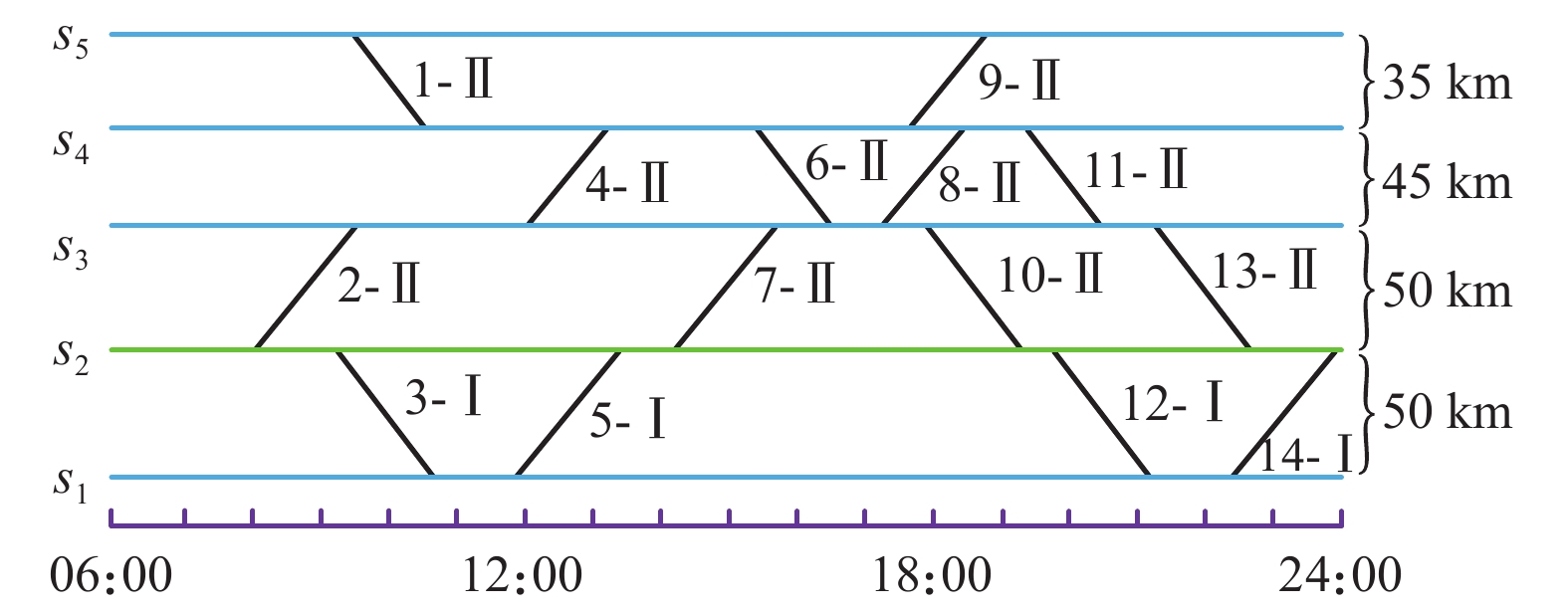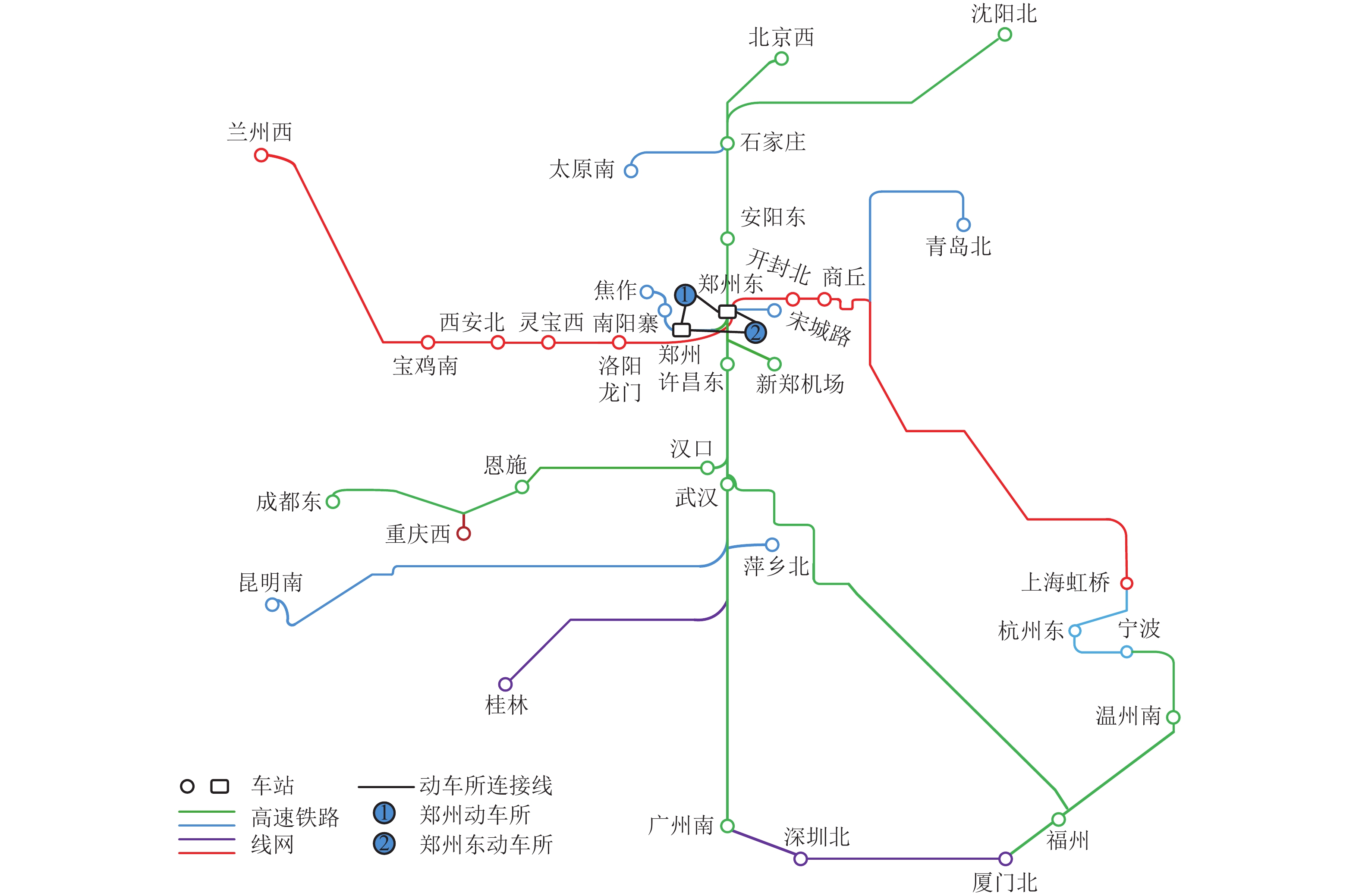Optimization Model and Algorithm for Train-Set Scheduling Based on Trip Sequence
-
摘要: 动车组运用计划的编制通常需要综合考虑运输安全、效率及成本等多方面因素,其编制质量及编制效率对高速铁路运营有重要影响. 为了快速获得高质量动车组运用计划,以降低综合运营成本和总空驶里程等为优化目标,建立了基于列车车次的可改编动车组运用优化混合整数线性规划模型,并设计了一个迭代逼近算法框架. 该算法框架将整个问题分解为主问题和子问题,其中主问题的最优解为整个问题提供有效下界,而主问题可行解集合中能够通过子问题检验的解为整个问题提供有效上界,从而算法框架可以不断地更新上、下界之间的最优间隙,迫使生成更接近于下界的新可行解. 多个实例分析表明:所提出的方法与人工方法相比,能够快速生成动车组运用计划,且使得动车组综合运营成本平均下降10.5%,总空驶里程平均减少23%.Abstract: Usually, the train-set schedule involves several practical aspects, such as operational safety, efficiency, and cost. The quality and efficiency of the schedule have a significant impact on the operation of high-speed railways. In order to quickly obtain a high-quality train-set schedule, a mixed-integer linear programming (MILP) model that takes composition changes on the basis of the trip sequences was established with the optimization goals of reducing operating costs and total deadhead mileages. Furthermore, an iterative gap reducing algorithm is developed to solve the MILP model, which divides the whole problem into the master problem and sub-problem. The master problem provides an effective lower bound for the whole problem, and its solutions that can pass the sub-problem provide an effective upper bound for the whole problem. As a result, the algorithm can continuously reduce the gap between bounds and generate a new feasible solution towards the lower bound. The real cases show that compared with the manual method, the proposed method can generate a high quality one-day train-set schedule in a short time, which reduces the total operating costs by 10.5% and the total deadhead mileage by 23%.
-
表 1 动车组单元基本量信息
Table 1. Basic information of EMUs
动车编号 动车类型 累积时间/min 累积里程/km 1 AL 1 440 800 2 AL 1 440 800 3 AL 0 0 4 AL 0 0 5 A 1 440 2 000 6 A 1 440 2 000 7 A 0 0 8 A 0 0 表 2 各动车所不同类型的动车组单元保有量信息
Table 2. Information of EMUs for different depots
组 数据 动车所 380AL 380A 380B 6A 数据 1 郑州 0 7 11 0 郑州东 36 9 28 0 数据 2 郑州 0 0 0 8 郑州东 34 16 40 0 表 3 不同策略下各案例的动车运用计划关键技术指标
Table 3. Key statistics of train-set scheduling cases under different scenarios
数据 运营策略 方案 RS/km ARL/km MRL/km MARL/km AERL/km ERL/km OP/组 OBJ/元 OBJSP/元 CT/s 数据 1 策略 1 下界 53 2577.7 509 4771 61.7 3273 13 110053 735117 13 算法 53 2577.7 509 4771 61.7 3273 13 110053 742809 108 人工 57 2435 183 4898 92.8 5291 13 124471 745915 策略 2 下界 51 2678.0 320 5419 63.7 3247 13 109727 705117 17 算法 51 2678.0 320 5419 63.7 3247 13 109727 705117 17 数据 2 策略 1 下界 66 2720.0 554 5316 72.2 4765 18 145862 916365 20 算法 66 2720.4 324 5188 72.8 4804 18 145904 903375 120 人工 70 2575.7 571 5229 74.8 5240 18 160753 945812 策略 2 下界 65 2760.8 660 5316 72.9 4736 18 145336 888375 22 算法 65 2760.8 631 5434 72.9 4736 18 145536 894313 120 注:人工方案并未统计具体的编制时间. -
彭其渊,李建光,杨宇翔,等. 高速铁路建设对我国铁路运输的影响[J]. 西南交通大学学报,2016,51(3): 525-533. doi: 10.3969/j.issn.0258-2724.2016.03.011PENG Qiyuan, LI Jianguang, YANG Yuxiang, et al. Influences of high-speed railway construction on railway transportation of China[J]. Journal of Southwest Jiaotong University, 2016, 51(3): 525-533. doi: 10.3969/j.issn.0258-2724.2016.03.011 尹深, 曾伟. 全国铁路今起实行新的列车运行图. [EB/OL]. 人民网, (2019-04-10)[2019-04-10]. http://society.people.com.cn/n1/2019/0410/c1008-31021820.html? utm_source=UfqiNews ABBINK E, BERG B V D, KROON L, et al. Allocation of railway rolling stock for passenger trains[J]. Transportation Science, 2004, 38(1): 33-41. doi: 10.1287/trsc.1030.0044 ALFIERI A, GROOT R, KROON L, et al. Efficient circulation of railway rolling stock[J]. Transportation Science, 2006, 40(3): 378-391. doi: 10.1287/trsc.1060.0155 FIOOLE P J, KROON L, MARÓTI G, et al. A rolling stock circulation model for combining and splitting of passenger trains[J]. European Journal of Operational Research, 2006, 174(2): 1281-1297. doi: 10.1016/j.ejor.2005.03.032 MARÓTI G, KROON L. Maintenance routing for train units:the transition model[J]. Transportation Science, 2005, 39(4): 518-525. doi: 10.1287/trsc.1050.0116 GÁBOR M, LEO K. Maintenance routing for train units:the interchange model[J]. Computers & Operations Research, 2007, 34(4): 1121-1140. 史峰,周文梁,郁宇卫,等. 客运专线动车组运用计划优化模型与算法[J]. 铁道学报,2011,33(1): 1-13. doi: 10.3969/j.issn.1001-8360.2011.01.001SHI Feng, ZHOU Wenliang, YU Yuwei, et al. Optimized model and algorithm of motor trains-sets scheduling for dedicated passenger lines[J]. Journal of the China Railway Society, 2011, 33(1): 1-13. doi: 10.3969/j.issn.1001-8360.2011.01.001 赵鹏,富井规雄. 基于路段交换的多基地动车组运用计划的编制算法[J]. 铁道学报,2004,26(1): 7-11. doi: 10.3321/j.issn:1001-8360.2004.01.002ZHAO Peng, NORIO Tomii. An algorithm for multiple-bases train-set scheduling based on path-exchange[J]. Journal of the China Railway Society, 2004, 26(1): 7-11. doi: 10.3321/j.issn:1001-8360.2004.01.002 王莹,刘军,苗建瑞. 基于列生成算法的动车组检修计划优化[J]. 中国铁道科学,2010,31(2): 115-120.WANG Ying, LIU Jun, MIAO Jianrui. Column generation algorithms based optimization method for maintenance scheduling of multiple units[J]. China Railway Science, 2010, 31(2): 115-120. 李建,林柏梁,耿令乾,等. 基于交路接续的动车组运用计划优化模型与算法[J]. 交通运输系统工程与信息,2015,15(5): 172-177,194.LI Jian, LIN Boliang, GENG Lingqian, et al. Optimizaiton model and algorithm for motor trainset utilization scheduling based on routes connection[J]. Journal of Transportation Systems Engineering and Information Technology, 2015, 15(5): 172-177,194. LI J, LIN B, WANG Z, et al. A pragmatic optimization method for motor trainset assignment and maintenance scheduling problem[J]. Discrete Dynamics in Nature & Society, 2016(3): 1-13. BORNDÖRFER R, REUTHER M, SCHLECHTE T, et al. Integrated optimization of rolling stock rotations for intercity railways[J]. Transportation Science, 2016, 50(3): 863-877. doi: 10.1287/trsc.2015.0633 高博, 曹国厂. 我国首列可变编组动车组已具备出厂条件[EB/OL]. 新华网, (2019-02-25)[2019-02-25]. http://www.gd.xinhuanet.com/newscenter/2019-02/25/c_1124157073.htm 殷勇,陈锦渠,朱蔓,等. 城市轨道交通站点失效修复策略[J]. 西南交通大学学报,2020,55(4): 865-872.YIN Yong, CHEN Jinqu, ZHU Man, et al. Repair strategies for failure of urban rail transit stations[J]. Journal of Southwest Jiaotong University, 2020, 55(4): 865-872. ZHONG Q, LUSBY R M, LARSEN J, et al. Rolling stock scheduling with maintenance requirements at the Chinese high-speed railway[J]. Transportation Research Part B: Methodological, 2019, 126: 24-44. -






 下载:
下载:





